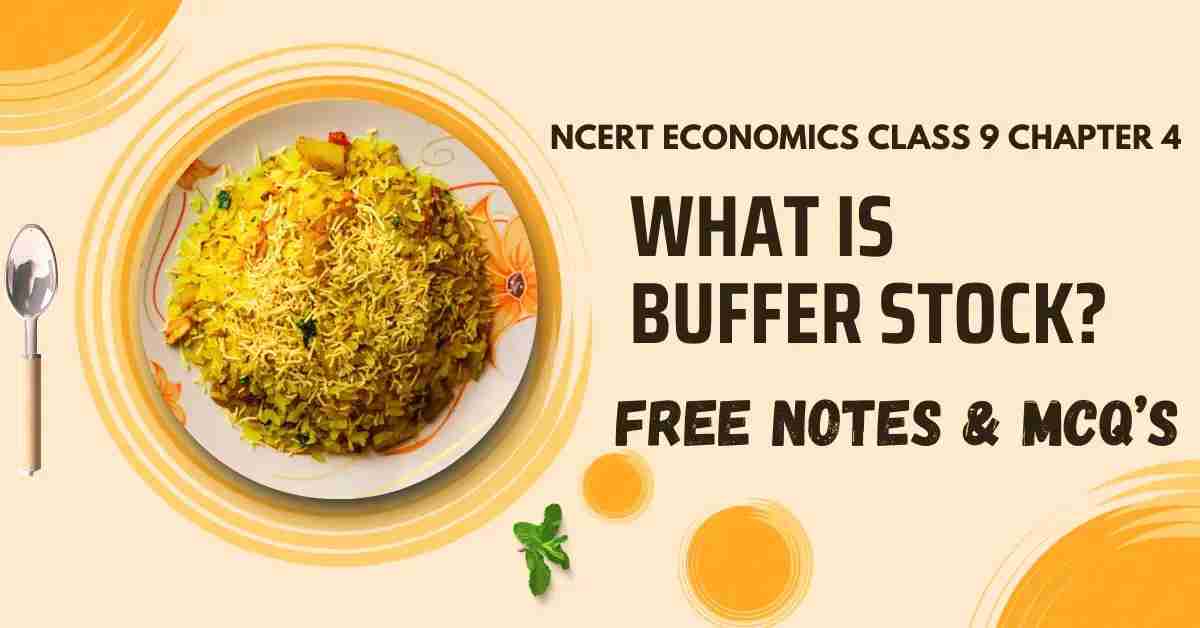What is Buffer Stock? – Concept & Notes PDF
Topic covered: What is Buffer Stock? and MCQs Questions: Food Security in India (All single detail notes are exam-oriented).
We have discussed in-depth and exam-oriented pointers that can be asked in the board exam of class 9th about the “What is Buffer Stock?“ from the NCERT Economics notes for class 9th chapter 4 Food Security in India.
Download the NCERT Economics for Class 9th Chapter 4 Food Security in India Notes PDF
Chapter 4: Food Security in India in Class 9 Economics highlights why access to food is essential for every citizen and how the government ensures it through systems like the Public Distribution System (PDS). The chapter also discusses the role of agriculture, buffer stocks, and rationing in preventing food shortages. Students often struggle to connect these policies with real-life examples, so these notes simplify the concepts in a straightforward way. Download the NCERT Economics for Class 9th Chapter 4 Food Security in India Notes PDF to quickly revise definitions, important terms, and exam-oriented points without feeling overwhelmed.
What is Buffer Stock?
1. Buffer Stock – Meaning:
- Buffer Stock is the stock of foodgrains, mainly wheat and rice, procured by the government.
- It is managed through the Food Corporation of India (FCI).
2. Procurement of Buffer Stock:
- FCI purchases wheat and rice from farmers in surplus production states.
- Farmers are paid a pre-announced price for their crops.
- This price is called the Minimum Support Price (MSP).
3. Minimum Support Price (MSP):
- Declared by the government every year before the sowing season.
- Purpose: To encourage farmers to increase production of wheat and rice.
4. Storage:
- Purchased foodgrains are stored in granaries.
5. Purpose of Buffer Stock:
- To distribute foodgrains in deficit areas.
- To supply food to poorer sections of society at a lower price.
- This lower price is called the Issue Price.
- To tackle food shortages during adverse weather conditions or calamities.
Next & Previous Topics of NCERT/CBSE Economics Class 9 Chapter 4: Food Security in India
MCQs on NCERT Economics Class 9 Chapter 4 Topic – What is Buffer Stock?
Here are the top exam-oriented MCQ-type questions on “What is Buffer Stock?” that you should prepare for your CBSE or state board exams:
Question 1. What is meant by Buffer Stock?
a) Stock of pulses procured by the government
b) Stock of foodgrains stored by farmers for personal use
c) Stock of wheat and rice procured by the government through FCI
d) Stock of fruits stored for export
Answer: c) Stock of wheat and rice procured by the government through FCI
Question 2. Which agency is responsible for procuring foodgrains under Buffer Stock?
a) NABARD
b) Reserve Bank of India
c) Food Corporation of India
d) NITI Aayog
Answer: c) Food Corporation of India
Question 3. From where does the government procure wheat and rice for Buffer Stock?
a) From deficit regions
b) From surplus producing states
c) From international markets
d) From private companies
Answer: b) From surplus producing states
Question 4. The price at which the government purchases crops from farmers for Buffer Stock is called:
a) Issue Price
b) Fair Price
c) Minimum Support Price
d) Procurement Price
Answer: c) Minimum Support Price
Question 5. Who declares the Minimum Support Price (MSP)?
a) Farmers’ Cooperatives
b) Reserve Bank of India
c) Government of India
d) State Governments
Answer: c) Government of India
Question 6. When is the MSP declared?
a) After the harvesting season
b) During the monsoon season
c) Before the sowing season
d) During festivals
Answer: c) Before the sowing season
Question 7. Why does the government declare MSP before the sowing season?
a) To fix ration shop prices
b) To provide incentives to farmers for raising production
c) To control inflation
d) To help exporters
Answer: b) To provide incentives to farmers for raising production
Question 8. Where are the foodgrains purchased under Buffer Stock stored?
a) Cold storages
b) Godowns of private traders
c) Granaries
d) Banks
Answer: c) Granaries
Question 9. At what price are foodgrains distributed from Buffer Stock to poorer sections of society?
a) At MSP
b) At Market Price
c) At Issue Price
d) At Procurement Price
Answer: c) At Issue Price
Question 10. Why does the government distribute foodgrains at Issue Price?
a) To earn profits
b) To help exporters
c) To supply foodgrains to poorer strata at lower price than market rate
d) To encourage private companies
Answer: c) To supply foodgrains to poorer strata at lower price than market rate
Question 11. Buffer Stock helps in resolving which of the following problems?
a) Food shortage during adverse weather conditions
b) Decline in industrial production
c) Shortage of oil and petroleum
d) Unemployment in urban areas
Answer: a) Food shortage during adverse weather conditions
Question 12. During which situations does Buffer Stock play a vital role?
a) Periods of industrial expansion
b) Periods of calamity and adverse weather conditions
c) Periods of political instability
d) During international trade negotiations
Answer: b) Periods of calamity and adverse weather conditions

